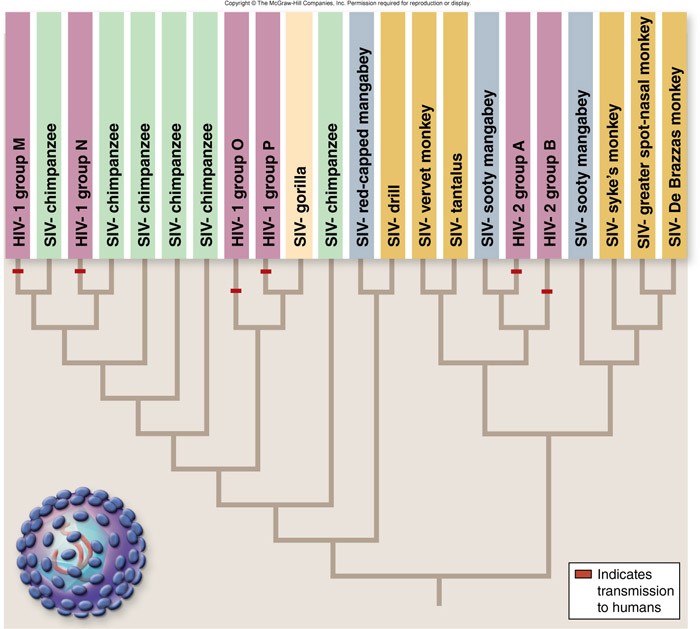The figure shows the evolution of HIV and SIV. Choose the true statements about the evolution of HIV. (Select all that apply.) A) All strains of HIV are included within clades with SIV strains.B) A strain of HIV is never more closely related to another strain of HIV than it is to a SIV strain.C) Humans acquired different subtypes of HIV from different primate hosts.D) HIV-1 group O is more closely related to SIV-chimpanzee than SIV-gorilla.E) All strains of SIV are included within clades with HIV strains.
A) All strains of HIV are included within clades with SIV strains.B) A strain of HIV is never more closely related to another strain of HIV than it is to a SIV strain.C) Humans acquired different subtypes of HIV from different primate hosts.D) HIV-1 group O is more closely related to SIV-chimpanzee than SIV-gorilla.E) All strains of SIV are included within clades with HIV strains.
What will be an ideal response?
A, B, C
Clarify Question
• What is the key concept addressed by the question?
o This question addresses cladistics.
• What type of thinking is required?
o This question is asking you to analyze the information given, using logic, to dissect the problem and determine the answer.
• What key words does the question contain and what do they mean?
o HIV is the human immunodeficiency virus, the virus that causes AIDS in humans.
o SIV is the simian immunodeficiency virus, which infects other primates.
Gather Content
• What do you already know about cladistics?
o Cladistics is the method used to construct a cladogram-a graphically represented hypothesis of evolutionary relationships.
o Only shared derived characters are useful for inferring phylogenies, and they must be contrasted to an outgroup that has the ancestral characters.
o Each nested clade is defined by a new shared derived character.
Consider Possibilities
• Consider the different answer options. Which can you rule out?
o Is HIV-1 group O more closely related to SIV-chimpanzee than SIV-gorilla? No. Look carefully at the cladogram, and you can see that HIV-1 group O forms a clade with HIV-1 group P and SIV-gorilla. Although the words SIV-chimpanzee are close, the actual branching on the diagram shows that that is more distantly related.
o Are all strains of SIV included within clades with HIV strains? No. Look to the clade of four strains on the far right; they form a clade without any closely related HIV strains.
Choose Answer
• Given what you now know, what information and/or problem-solving approach is most likely to produce the correct answer?
o Are all strains of HIV included within clades with SIV strains? Yes. Each of the six purple HIV strains lie in clades that also have at least one SIV strain.
o Is a strain of HIV never more closely related to another strain of HIV than it is to a SIV strain? Yes, this is correct.
o Did humans acquire different subtypes of HIV from different primate hosts? Yes, that is the most likely interpretation from these relationships, that HIV strains came from different primate SIV strains.
Reflect on Process
• Did your problem-solving process lead you to the correct answer? If not, where did the process break down or lead you astray? How can you revise your approach to produce a more desirable result?
o This question asked you to choose true statements after interpreting a cladogram of HIV and SIV strains.
o The question required you to analyze the information given, using logic, to dissect the problem and determine the answer.
o Did you recognize that a cladogram of viruses is like a cladogram of species. The strains that branch off the same nodes are most closely related.
You might also like to view...
Which system is responsible for providing protection, regulating body temperature, and being the site of cutaneous receptors?
You have been asked to construct a physical map of the baboon genome. What would be helpful in this task?
A. chromosome maps and STSs B. BLAST and ENCODE data C. gene linkage data D. microarrays and SAGE Clarify Question · What is the key concept addressed by the question? · What type of thinking is required? · What key words does the question contain and what do they mean? Gather Content · What do you already know about physical mapping? Consider Possibilities · Consider the different answer options. Which can you rule out? Choose Answer · Given what you now know, what information and/or problem solving approach is most likely to produce the correct answer? Reflect on Process · Did your problem-solving process lead you to the correct answer? If not, where did the process break down or lead you astray? How can you revise your approach to produce a more desirable result?
Who developed the two-part naming system
scientists use today to classify newly found organisms?
a. Charles Darwin b. Carolus Linnaeus c. Aristotle d. Alexander von Humboldt e. Ernst Mayer
Water that is filtered out of the blood by the kidneys is returned to the body through the action of aquaporins. Which of the following statements about water balance disorders is scientifically accurate?
A) People with heart failure often swell due to too much water from excess numbers of aquaporins. B) Water retention (too much water) in pregnancy can be due to a decreased number of aquaporins. C) Kidney failure and decreased urine production are due to increased numbers of aquaporins. D) Small amounts of urine are produced by people who inherit a defect in the ability to make aquaporins.